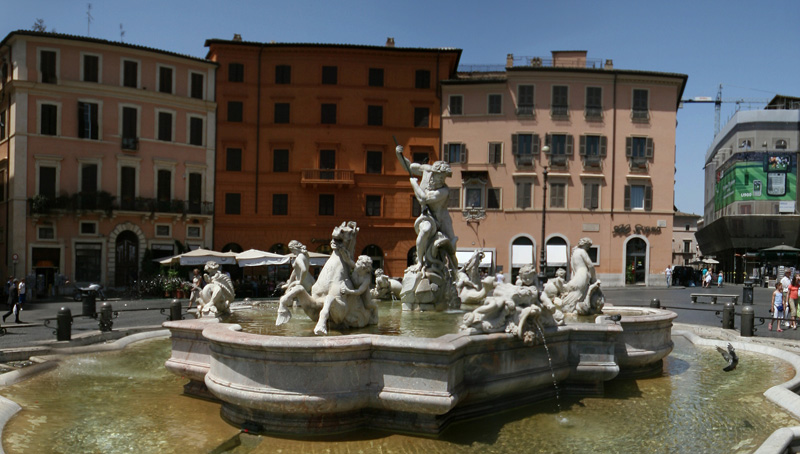Fountain of the Four Rivers - The Fountain of the Four Rivers ("Fontana dei Quattro Fiumi") occupies the center of the large oval Piazza Navona. It is a masterpiece of Gian Lorenzo Bernini's, and emblematic of the dynamic and dramatic effects sought by high Baroque artists. It was erected in 1651 in front of the church of Sant'Agnese in Agone. The fountain means to depict allegories for the four great rivers in the four continents recognized by the Renaissance geographers: the Nile in Africa, Ganges in Asia, Danube in Europe and Rio de la Plata in America. Each has a river god, semi-prostrate, in awe of the central tower, epitomized by the slender Egyptian obelisk (built for the Roman Serapeum in 81 AD), symbolizing by Papal power surmounted by the Pamphilj symbol (dove). A legend is that Bernini positioned the cowering Rio de la Plata River as if the sculpture was fearing the facade of the church of Sant'Agnese by his rival Borromini could crumble against him; in fact, the fountain was completed several years before Borromini began work on the church.
Fountain of the Neptune - The Fountain of the Neptune, also known as the Fountain of the Boilermakers, is located at the northern extermity of Piazza Navona. The work owns the design and the realisation of its tank to the same Giacome della Porta author of the tank of the Moor Fountain at the opposite extremity of the square. It reached the unification of Italy without any decorations, and therefore to give to the Fountain of the Neptune a stylish similarity with the other fountains of the area, a competition was issued in 1878 for the realisation of the monumental apparatus; such competition was won by Gregorio Zappalà and Antonio Della Bitta. The first one realised the decoration complex based on the mythological theme of the "Nereidi with cupids and walruses", the second one realised the group of marbles "Neptune fighting with an octopus".
 Moor Fountain - The Moor Fountain, located in the southern area of Piazza Navona, takes its name from the group of sculptures of the tank representing an Ethiopian fighting with a dolphin. The work, sculptured on a design of Bernini in 1654 by Giovanni Antonio Mari and which, in reality, should represent a triton, was expressly required by the sister-in-law of Innocent X, Olimpia Maidalchini, in order to give an ideal achievement to the tank realised by Giacomo della Porta, already placed on the square by the Pontiff Gregorio XIII in 1576.
Moor Fountain - The Moor Fountain, located in the southern area of Piazza Navona, takes its name from the group of sculptures of the tank representing an Ethiopian fighting with a dolphin. The work, sculptured on a design of Bernini in 1654 by Giovanni Antonio Mari and which, in reality, should represent a triton, was expressly required by the sister-in-law of Innocent X, Olimpia Maidalchini, in order to give an ideal achievement to the tank realised by Giacomo della Porta, already placed on the square by the Pontiff Gregorio XIII in 1576. Church of Sant'Agnese in Agone - The construction of the Church of Sant'Agnese in Agone started in 1652 on the site, as a legend wants, where Sant'Agnese was martyred in the Circus of Domitian. The first designs, by Girolamo Rainaldi in 1652, were for a Baroque church. They were commissioned by Pope Innocent X, whose funerary monument is housed within the church. The Pope's family, the Pamphilj, had a large palace adjacent and the church was to be a sort of a personal chapel annexed to the their residence. In the years 1653-1657 the works of the facade were completed by the important Baroque architect Francesco Borromini, who changed the distance between the two side towers and introduced a concave volume in the centre. Sant'Agnese in Agone is considered among Borromini's most restrained creations. The construction was completed by Carlo Rainaldi, son of Girolamo. The church has a Greek cross plan. The interior of the dome has paintings portraying the Martyrdom of St. Agnese (1670-1689) by Ciro Ferri and Sebastiano Corbellini. Under the church there are substantial remains of an ancient Roman house. The premier artwork in this church is sculptural, crowned by the marble relief in the main altar, placed in a setting installed by Carlo Rainaldi and Ciro Ferri, that depicts the Miracle of Sant'Agnese, initially commissioned from Alessandro Algardi, and completed by Ercole Ferrata and Domenico Guidi in 1688, under constraints that their product must remain in conformity with the original Algardi design.






No comments:
Post a Comment